Critiques de films & livres - chroniques diverses et variées / Film and Books Reviews - Various Curiosities and Chronicles
Don't wanna be here? Send us removal request.
Text
GROSSE CLAQUE ! The Devil All the Time (Critique)
The Devil All the Time Antonio Campos, 2020 D’après l’oeuvre originale de Donald Ray Pollock
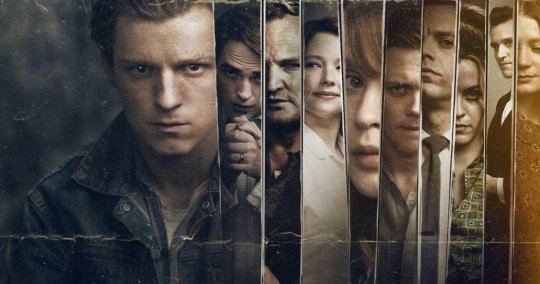
ATTENTION, GROSSE CLAQUE DE SEPTEMBRE ! (ET SPOILERS CI-DESSOUS, NE LISEZ QUE SI VOUS AVEZ VU LE FILM !!!) “Quelle intensité dans le jeu !” Voilà la phrase qui ne m’a pas lâché durant tout le visionnage de ce Devil All the Time ( “Le Diable, tout le temps” en français ). Sincèrement, quelle claque et quel pied de voir un film où le jeu de tous les interprètes est réglé au cordeau, où un mélange de fiévreuse intensité côtoie une violence sourde et intérieure prête à surgir, où les silences remplis de tension attendent d’exulter hors de corps tendus et courbés. Chapeau bas donc, à commencer par un Tom Holland méconnaissable, qui troque ici son image de play-boy super-héros contre un rôle tout en nervosité en incarnant le personnage d’Arvin. Ce grand sec taiseux bouffé par une rage sourde qui embrase tout l’écran, Holland lui donne une force insoupçonnée, une brutalité sans vergogne. À travers des mâchoires serrées, il lâche ses phrases comme des grognements, des bougonnements d’ado. Avant de pouvoir enfin, dans les toutes dernières minutes du film, relâcher le corps tout entier pour tomber de fatigue avec aise...
À ce titre, ce bâillement face caméra à la fin est d’une puissance insoupçonnée ; dénotant à la fois d’un lâcher-prise colossal de l’acteur qui accepte de se donner entièrement à la caméra dans tout son naturel peu glorieux et en même temps, donnant enfin (et pour la première fois) la permission au personnage d’Arvin de ne plus se retenir et de laisser s’échapper, détendu et dans sa totalité, ce soupir de soulagement et d’éreintement à la fois. Enfin les mâchoires s’étirent, la gueule s’ouvre… à l’instar de la route infinie qui se déroule devant lui et qui lui offre peut-être, au creux de son repos, un ticket pour la liberté.
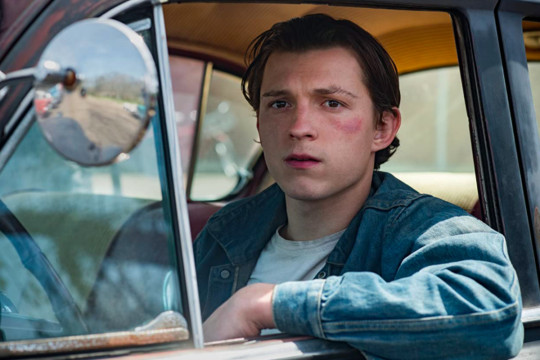
Mais outre Tom Holland, qui n’a pas fini de nous surprendre, le film est porté par un casting prestigieux et des seconds rôles marquants (Mia Wasikowska, toute en fragilité ; Bill Skarsgård, qui démontre une réelle palette d’acteur et qu’on préfère largement ici plutôt que dans son interprétation grotesque de Pennywise) qui font toute la beauté du film et concourent à sa réussite. Certes, si l’accent travaillé par Pattinson ne convainc pas toujours et déroute parfois, on ne peut néanmoins pas lui retirer la réussite magistrale dans la dose d’excentricité qu’il apporte à sa composition du Révérend Teagardin, prédicateur pervers et vicieux au possible, prouvant ainsi qu’il est l’un des acteurs les plus surprenants de sa génération et dont les choix de rôles sont aussi inattendus les uns que les autres d’un film à un autre. Je suis curieux de voir ce qu’il nous réserve pour la suite...
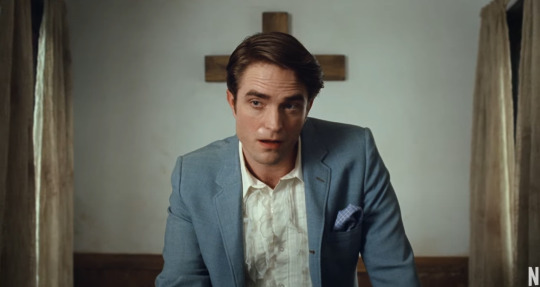
Le film en lui-même nous mène donc d’un destin à un autre, de vie en vie, ballotté comme les orphelins que sont Arvin et Lenora avant de comprendre, grâce à un scénario et une mise en scène habiles, comment tout finit par être relié... Baigné d’une lumière sépulcrale et avec une image légèrement granuleuse (superbe travail du chef op’ Lol Crawley), le film est narré par une voix-off, celle de Donald Ray Pollock, l’auteur du livre dont le film est l’adaptation. Belle idée d’un auteur-narrateur de son propre écrit et omniscient, qui observe ses personnages de papier prendre vie sous ses yeux et être les jouets de sa volonté alors que le film se déroule et mêle les destins de tous ses personnages dans une longue ligne de fuite angoissée dont le rassemblement en un point convergeant à la fin donne tout son sens...
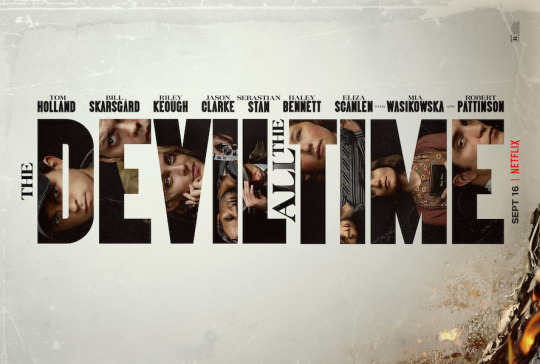
Non content de dresser le portrait de personnages heurtés par la vie, malmenés, humiliés, abandonnés, le film (et le livre avant lui probablement) porte en creux une critique sur le facteur commun à toute la misère humaine, qui s’en nourrit et qui la cause, et qui tient en un seul mot : religion. Arvin n’est d’ailleurs pas dupe là-dessus, lui qui trouve la voiture du Révérend Teagardin bien trop “tape-à-l’oeil” pour un homme de sa fonction ; lui encore qui a décidé de ne plus prier après que la croyance aveugle et dévouée de son père placée dans le Seigneur l’a poussé à se suicider ; et lui encore qui perdra sa demi-soeur à cause d’un Révérend qui détourne les paroles divines à des fins sexuelles…
Sorte de film choral aux très forts relents de noirceur et de sang, The Devil All the Time ne laisse aucun répit au spectateur puisque, fidèle au titre, le Diable dans cette histoire est partout, tout le temps. Qu’il prenne les traits d’un Pasteur farfelu qui se croit habité par Dieu et tue sa femme dans l’espoir de la ressusciter... ou la forme d’un cancer qui ravage et la mère d’Arvin et son père qui, pris de folie, crucifiera leur chien dans l’espoir de guérir sa femme... oui, Le Diable est partout et prend en réalité maintes formes dans le film (et très certainement dans le livre de Pollock) mais est souvent placé sous l’égide d’une seule et même entité : la religion. La religion, quand elle est croyance aveugle et confiance trop dévouée, est un piège vecteur de folie, nous dit le film, se diffusant comme des pensées pernicieuses. C’est elle qui crée le Diable tout le temps, illusionnant ses fidèles et les condamnant à l’Enfer, victimes de leurs propres croyances.
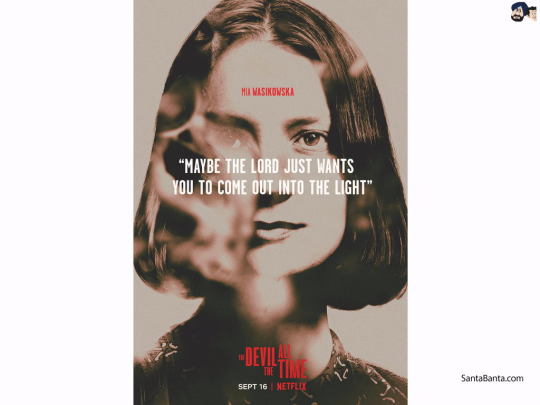
En cela, on pourrait donc presque voir en Arvin une figure rédemptrice, qui décide de rendre la justice par lui-même (presque dans la tradition du vigilante) et qui ne succombe jamais à la facilité de la prière illusoire ni à aucune croyance de quelque ordre que ce soit : on l’entend d’ailleurs répondre “c’est ridicule” à Lenora qui lui demande s’il ne voudrait pas prier pour que son défunt père revienne... Et ce, à juste titre, car le seul moment où Arvin s’autorise à prier devant l’ancienne croix de son père est aussi l’instant-clé qui manque de marquer sa mise à mort puisqu’il ne doit qu’à son ouïe fine et à son instinct de combattant de se cacher au dernier moment, évitant les balles du shérif et l’exécutant juste après.
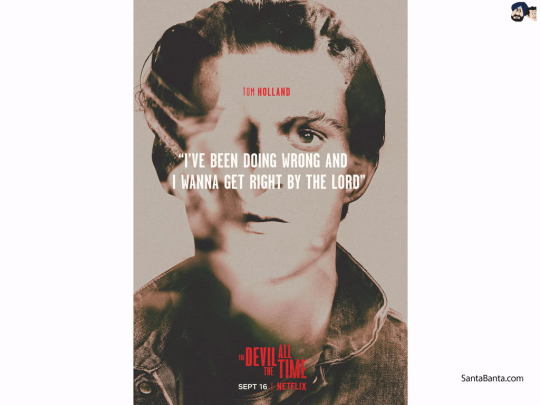
Finalement, c’est comme si quiconque entrait dans une église et souhaitait faire profession de foi devait en payer le prix : le vice ou la mort - quand ce n’est pas les deux.
VERDICT : C’est rare de voir un tel constat aussi violent porté à l’écran, par une mise en scène nerveuse, tendue et des interprètes d’une justesse implacable. On applaudit donc et on salue d’autant plus l’audace d'un tel point de vue.
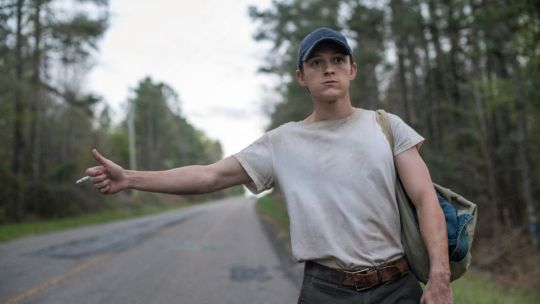
#the devil all the time#tom holland#robert pattinson#antonio campos#film review#critique#coup de coeur#cinema#netflix
0 notes
Text
Light Of My Life (Critique)
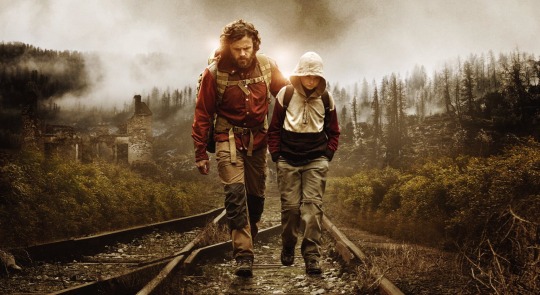
Light Of My Life Casey Affleck, 2020 “Dans un futur proche où la population féminine a été éradiquée, un père tâche de protéger Rag, sa fille unique, miraculeusement épargnée, qu’il décide de faire passer pour un garçon afin d’assurer leur survie à tous les deux. Mais comment maintenir l’illusion d’un quotidien insouciant et préserver la complicité fusionnelle avec sa fille dans un monde vacillant et brutal ?” Voilà donc le pitch prometteur d’un film qui s’annonce intimiste et, d’une manière, presque féministe puisque le seul espoir réside en la personne d’une petite fille. Si par l’histoire, le film rappelle forcément “Les fils de l’homme” de Cuaròn, il n’en a malheureusement pas la force d’expression ni la consistance dans son propos.

À vouloir trop resserrer sur l’intimité du duo père-fille, Affleck ne laisse pas de place à l’invitation du monde extérieur - certes considéré comme dangereux et primal mais qui aurait pu être encore mieux dépeint - dont les rares interventions hostiles constituent seulement des prétextes à quelques maigres scènes d’action qui atteignent leur apogée dans un combat final lourd, balourd et long. Au détour de scènes trop bavardes et peu intéressantes où Affleck se donne le beau rôle avec des lignes et des lignes de dialogue (il est à la fois réalisateur et acteur de son propre film), il ne parvient pas à convaincre un spectateur qui finit par étouffer dans ce monde âpre - mais pas pour les raisons que l’on aimerait. La scène d’ouverture, en ce sens, illustre parfaitement le reste du film, dans sa tentative de raconter un conte post-apocalyptique - en forme de métaphore (ratée) à leur parcours à deux - mais qui se perd dans des lenteurs dispensables et qui ne mène finalement à rien.

Si la grande partie du film en devient insupportable par les monologues interminables du père, il faut cependant rendre justice au jeu très juste et poignant de la jeune actrice Anna Pniowsky (Rag). Seul son personnage tire son épingle du jeu, avec ses remarques lucides et tranchantes en avance sur le rabâchage de son père.
Une belle lumière froide et hivernale qui baigne le long-métrage et de très beaux plans de paysages froids et enneigés ne suffisent néanmoins pas à nous sortir du sentiment pénible que tout cela est bien trop froid et empesé pour susciter une véritable émotion. Et c’est très nettement ce qui manque ici, cet élément indispensable : l’émotion. Cela est dû en grande partie à Affleck qui oublie d’exposer clairement les règles du jeu de ce nouveau monde chaotique en se contentant d’une ou deux excursions en villes pour “donner une idée” ; ou de quelques explications épisodiques par le biais de coupures de presse ; ou encore, de courts souvenirs douloureux avec sa défunte femme atteinte de ce mal mystérieux (Elizabeth Moss, toujours aussi impeccable mais qu’on préfère grandement dans “The Invisible Man” de Leigh Whannell, chronique à venir ! ). Toutes ces bribes qui, en définitive, ne font pas réellement comprendre comment tout marche dans ce ‘monde d’après’... VERDICT ? In fine, trop de pistes peu voire pas assez exploitées pour un film au rythme mort mais aux plans de nature rugueux baignant dans une lumière automnale-hivernale qui donnent à l’image une qualité désaturée et brute qui constituent le seul point fort du film. On retient surtout l’interprétation remarquable et toute en finesse de la jeune Anna Pniowsky mais tous ces éléments ne suffisent pas à sauver un film aux dialogues trop écrits et à la mise en scène empesée.

2 notes
·
View notes
Text
The 400 Blows (François Truffaut, 1959)

The seaside. A runaway in the woods… under a bridge… on the road…. and finally on the beach. Feet in the water, slowing down… Eyes gazing through the horizon… Then a frank look at the lens - quickly caught by the camera - from a 13-year-old cocky kid.
The image freezes.
The final shot of The 400 Blows is one of those iconic images that stay in your mind decades after you’ve seen the film. Being a feature centered around the street education and wanderings of a boy left to his own devices, it makes sense that The 400 Blows wouldn’t – and can’t – come with an expected ending.
The film is raw, organic and shot in the ‘tradition’ of the French New Wave, having an almost documentary approach to its characters and their surroundings.
Through the entire film, the camera sticks to them (especially to Antoine Doinel, the main protagonist), follows them in their tribulations and always remains at their level. The rhythm of the film embraces the inner turmoil of a young boy unloved by his mother and completely misunderstood by his father. The editing is made of short, effective cuts, just like the constant snap in the thinking of Doinel’s mind and his longing to run away from everything: school, home, jail, education center…
What Truffaut succeeded in with this particular film, is not only delivering a part of himself in this very personal work, but combining with great simplicity and authenticity pure moments of poetry with harsh real-life scenes. The most significant example being this succession of shots of Dosnel spending a night out in the streets of Paris, unshamingly stealing a bottle of milk that he gulps in one shot and in the background, having his touching (though mispelled) letter read in voice-over by his parents…
But if 400 Blowsis also so impactful and so cherishable in the heart like a memory gem from childhood, it is also thanks to a beautiful and memorable score by Jean Constantin, who manages, with a few repetitive and endearing notes on strings and keyboards, to build an enveloping and mellow melody fully reflecting on Doinel’s cruel outcry for freedom. In that sense, the scene where Antoine gets arrested and thrown into a police car is one of the most heartbreaking and symbolic scenes in cinema history.
As he watches the night lights of Paris through the bars of the back of the car, the score softly brings a melancholy tone as the young boy aspiring to become a man sheds silent tears… Cars go by in busy Paris and at this precise moment, him as well as us, spectators in the dark, get a sense of a great injustice and misunderstanding.
Then bars superpose on other bars, this time in a jail for juvenile delinquents, and then it’s done with freedom and leisure life – the only real one that allowed Antoine to feel if not found, at least belonging where he wanted to belong.
And that’s where lies one of the forces of this timeless film, portraying the eternal craving for love and acceptance against an hypocrite and rigid society.
To me, that’s where the rebel inside Truffaut (who wrote notably and favourably about the youth portrayed by James Dean in Rebel Without a Cause) expresses himself and aims to show us that any unusual, out-of-the-margin behavior is instantly repressed and punished by any kind of figure of authority. But the great thing with Truffaut is that he never allows his idea or statement to take over his story and his characters (which might not be the case of his pal Godard, who too often let his experiments on form absorbs his narrative).
Here, Truffaut creates and maintains a very deep connection between Antoine and his ‘partner in crime’, but also shows us the dreadful but forced solitude of youth when neglected by grownups. In its depiction of an unaffectionate and selfish adult world, the 400 Blows reaches then its highest poetical stand, echoing a bit from St Exupéry’s Little Prince: “All grown-ups were once children... but only few of them remember it.”
Which is why the tireless screening of this film never gets tiring nor loses its magic ; for we’re always ready to reconnect to our inner child, especially in those thriving times.
#french cinema#french#culture française#françois truffaut#french new wave#nouvelle vague#antoine doinel#rebel#childhood#cocky#bad kids#godard#camera#film
2 notes
·
View notes
Text
If Beale Street Could Talk (3/3) - Review

LOVE & CREATION IN A WORLD OF AUTHORITY & REPRESSION
I’m beginning my series of reviews with a special Film Trio centered around the theme above. The three films reviewed and discussed are: 1) Cold War; 2) Never Look Away & 3) If Beale Street Could Talk.
Having seen those three films with a few weeks interval, I feel they shared really great similitudes in their treatment of love, of the artist’s place in society and of the importance of memory.
I hope you’ll enjoy this last one!
If Beale Street Could Talk (3/3) Barry Jenkins, 2018
Black Power Love Story
After Moonlight and its both very direct and poetic approach to homosexuality in the Black community, Barry Jenkins comes back with an adaptation of James Baldwin’s novel, If Beale Street Could Talk. Centered around a young African-American couple, Fonny and Tish, evolving in 1970’s Harlem in America, both the novel and the film follow the struggle of a lifetime to fight an injustice that sent Fonny behind the bars, leaving Tish on her own with a baby to come…

As the last part of the triptych “Art & Creation in a world of Authority & Repression”, If Beale Street Could Talk’s narrativeis in that very similar to Cold War’s and Never Look Away’s – following the memory of its characters (here especially Tish’s) and inviting us to their intimacy. If there’s no actual historical war as there is in the two other films, it’s because here it’s more about a hidden and personal one: Tish and her family’s battle. Their battle against an unfair justice system; their battle to gain a voice and make them recognize an African-American equal to a White one (“Call him Fonny!” imposes Tish to their lawyer); their battle to keep a baby healthy and surrounded with love; their battle to offer the father of this baby a chance to see him one day…
Through their quest is expressed a conflict that has been going on for years at that time in America (and sadly enough, is still raging nowadays), the one endlessly opposing White against Black and the unbearable injustices the second ones have to face.

And it is in this context of a racist America that Fonny and Tish fall in love. And when you see them, on screen, it’s obvious – that those two were meant to be together, just as were Kurt and Elizabeth, and Witkor and Zula. Here again, we witness the idea of love as a construction, as a co-creation that lifts up both individuals and gives them a reason to fight, to create, to live.

In If Beale Street Could Talk, it’s even a motivation to act. And make things moving when no one in the jurisdiction or in the administrative part is doing its best to find out the truth, re-interrogate the victim etc… The absence of understanding, the lack of support and the total and random control of the system over its individuals push individuals to act for themselves and protect their communities. Tish’s mother trip to meet the victim is a reaction and a way to regain power over the situation – at least for a time – against the overwhelming authoritarian system that said ‘No’ to their request and is ready to shut the case and lock away an innocent.

As we’ve seen it in the two other films, authority, power and control are what ‘kill’ purity – of art and of action. It’s only when one decides to confront it and refuse to be ‘bought’ by it that one can create. It’s the struggle that makes the artist who he is. And with Fonny and his pottery, we get another example – and another intimate experience – of an artist with his work. Fonny is compelled to create cause he hasn’t got anything on the side to sustain his family and also has purposefully decided to commit himself to his art – which englobes both his vases and the love of his life Tish.

The window offered here to the artist’s way has the same poetic elements that had Cold War and Never Look Away: that delicate scene in Fonny’s workshop where he shapes his pottery in a dusty light, the camera circling around him, slow-motion, almost dancelike… echoes in many ways scenes in the Paris bohemian apartment of Wiktor and Zula or Kurt’s painting room. And as in the two other films, If Beale Street Could Talk shares a same importance accorded to music, highlighted here by the precious and mellow score of Nicholas Britell and shaping love ballads along the way. A music that accompanies the memories of the characters, gives different colors to them and highlights the sensuality, the poetry of the images we’re seeing.

In the end, those three works also questions memory: what accurate memory do we have of historical events? What would we have rather forget? What memories of the time shared together do we have? Was one memory influenced by other people’s remembrance of it? And finally, how art is deeply connected to our inner child?

In the three films, we assist to a birth: whether it be the birth of love (the three of them); the birth of an identity as an artist (Cold War& Never Look Away) or the birth of a child (If Beale Street Could Talk). That is to mean that a work of art is nothing else than a long gestation until the artist delivers her/his baby to the world…
VERDICT? GO AND FALL IN LOVE WITH THOSE TWO!!

Last Words Overall, it is very interesting to see those three works echoing themselves and arriving in a time of dividing conflicts and ambiguities where the audience is being reminded that in the end, love is the answer (cheesy I know but couldn’t resolve myself to write anything else!)

#if beale street could talk#barry jenkins#love#moonlight#black power#black panther#director#film review#actor#james baldwin#america#2018#film adaptation#book#harlem
3 notes
·
View notes
Text
Never Look Away (2/3) - Review

LOVE & CREATION IN A WORLD OF AUTHORITY & REPRESSION
I’m beginning my series of reviews with a special Film Trio centered around the theme above. The three films reviewed and discussed are: 1) Cold War; 2) Never Look Away & 3) If Beale Street Could Talk.
Having seen those three films with a few weeks interval, I feel they shared really great similitudes in their treatment of love, of the artist’s place in society and of the importance of memory.
I hope you’ll enjoy what I finally came up with! Never Look Away (2/3) Florian Henckel Von DonnersMarck, 2019 Historical Dramatic Romance
After Cold War (see previous review), here comes another interesting take on an artist’s life during wartime period - but from the German side this time. Loosely based on Gerhard Richter’s art and life, Never Look Away(Werk Ohne Autor– Work Without An Authorin its German title) follows the artistic and love journey of a young aspiring painter, whose aunt has been the victim of Nazi atrocities during the War.Profoundly scarred by the locking of his aunt Elizabeth in a sanatorium and then her sending to a certain death, Kurt decides, from the day he witnesses her arrest, to study art and make painting the center of his life. But what he doesn’t suspect is the meeting with the love of his life, Ellie, who’s also gonna act as the main revelatory and instigator of his art - for her father seems to hide more than one secret, one of them being linked to Kurt’s very own past…

The film is set in Nazi Germany during Kurt’s childhood and then moves on to post-war East Berlin where the hunt for war murderers begins. Following Kurt’s evolution throughout the years, focused on the period from childhood to his very first exhibition, the three hours and nine minutes of Never Look Away never feel like it and actually allow for the emotions, the characters and the sensations to settle deeply and durably. It is exhilarating and reassuring to see that some filmmakers still fight and stand for their artistic vision by daring to release in the movies such long films, as Titanic or King Kong in their time. By not taking shortcuts or simplifying his narrative, Von Donnersmarck remains close to his characters and allow for us to fully live with them and feel like a part of their very intimate journey, in the middle of a troubled era and family secrets.

Similar to Cold War is this perfect balance between historical intrigue and love story, the subtle combination of the inner struggles linked to the combats of a nation to reestablish the truth and keep the memories of the victims alive. One of the (many) strengths of the film, just as in Cold War again, is the couple and their love relationship. Beautifully shot, alternating between really crude - yet poetic – scenes and more suggesting ones, Florian Henckel and his cinematographer Caleb Deschanel (known for his work on The Passion of the Christ) really embrace the fiery and burning passion between our two lovers, which you know from start are bond for life – just as were Wiktor and Zula. Tom Schilling’s fervor and mad dog attitude finds the perfect match with Paula Beer’s wit and softness as her dedicated lover – and later on, wife.

Both in an obvious chemistry, the film then seen through their eyes (mostly the ones of Kurt of course) is an incredible gem and an absorbing intimate quest about what makes one an artist, what really lies behind a work of art and how personal traumas can help through works of art reestablishing a sense of truth and emotion. All of these, which could just sound like a boring philosophical demonstration, are only underlying themes that are not pretentiously elaborated but rather suggested and in the most subtle and touching way. Through out the blurry/not blurry memory shots of Kurt’s past, Florian Heckel puts us in his shoes, forcing us to see through his eyes and confronting ourselves with what we’re willing to see… or rather not, preferring blinding ourselves.

As in Cold War, we observe the same idea of control and authority upon art, over freedom and experiment. This idea is represented in both films by a figure of domination and authority: in Cold War, it’s the larger-than-life and omnipresent photograph of Staline; in Never Look Away, it’s the character of Professor Carl Seeband, Ellie’s father. Both of the films portray artists looking for some kind of purity in art, far from the rigidity and ‘in the box’ canons of a regime which takes control over its citizens and their tools of self-expression.Talking about purity, it’s interesting to look at the character of Kurt’s aunt, Elizabeth.

She represents the duality that’s gonna haunt Kurt’s life and work, thinking of creations for the Fürher (creations in all senses, when she evokes giving him a baby…) but also disagreeing with the established notions of good art. Her madness seems to make her perceive the poetry of the world she’s evolving in and, maybe, attaining some kind of purity in that way cause she’s thinking “out-of-the-box” – extremely for sure, but nevertheless, not influenced by preconceived ideas or by any moral standards.

After such a beginning and a look through Kurt’s childhood, one understands and sympathizes even more with Kurt and his struggle to reach the emergence of his affirmed self through art, first occulted by the pleasure of newness but quickly returning to the essence of what he is and where he comes from, thanks to an harsh, though enlightening, comment on his first works: “This is not you”, his teacher simply puts it.

It then takes Kurt a lot of courage but also trust in his unconscious to go back to the unspoken traumas of his past and finally reconnect to his inner child, who’s gonna deliver the truth through his paintings. And that’s also when the filming of the colors and the come-and-go of the brush on the canvases get more intimate, with beautiful close-ups and the impression of being carried away by the brush and Kurt’s imagination, just as he is.

All of that accompanied during the whole feature with music by the prolific and always remarkable Max Richter, who, again, gifts us with a melancholic and dreamy score thatenhances the experience. Combined with the camera used as the painter’s brush, it offers a final painting of true beauty, amidst the carnage of horror.

VERDICT? GO AND GET FRAMED BY THIS BEAUTY!

#never look away#film#review#florian henckel von donnersmarck#cinema#the lives of others#max richter#love theme#war#art#gerhard richter#director#score#paula beer#tom schilling#academy award winner#masterpiece
4 notes
·
View notes
Photo

SPECIAL THEME:
LOVE & CREATION IN A WORLD OF AUTHORITY & REPRESSION
I’m beginning my series of reviews with a special Film Trio centered around the theme above. The three films reviewed and discussed are: 1) Cold War; 2) Never Look Away & 3) If Beale Street Could Talk.
Having seen those three films with a few weeks interval, I feel they shared really great similitudes in their treatment of love, of the artist’s place in society and of the importance of memory.
I hope you’ll enjoy what I finally came up with!
Cold War (1/3)
Paweł Pawlikowski, 2018
Romantic Social Drama
Paweł Pawlikowski’s new film comes all wrapped up in a sumptuous black-and-white - like his previous Ida- which contrast illuminates each scene throughout the entire feature, thanks to a raw and stripped off style of the cinematographer Lukasz Zal.

In heart-felt and almost documentary type shots, the film offers the portrait of a war-torn countryside, which pure and bared landscapes echo the difficulties of cold-hearted times. But inside that apparent cold, lies a human warmth, which is what Pawlikowski is interested in portraying. Portraits of men and women of all ages and all conditions shots as photographs of a nation, the film seems to reconnect to that golden age of Italian neo-realism. Where a film, throughout an apparent narrative, depicts the struggles of a country and its people - and especially the ones of lower classes.
Proof is that scene where the crowd coming from everywhere is waiting outside the auditorium to get in for auditioning. Filmed in a high-angle shot, it reminded me of a scene in Ladri di Bicicletta by Vittorio De Sica where, outside the job center, social workers are waiting to be called to get some work. Feverish, the audience waits for the main character’s name to be called, empathizing with him, hoping he’s gonna work today to earn the daily bread for his family. And as we know from the start that not everybody’s gonna get called. In the same way that, in Cold War, “not everyone is gonna get in and be seen today” - flat-out truth that a high level of demands cannot be answered. And all of that for the love of singing, the love of music.

That same music, central piece of the film and guiding thread connecting people and places throughout the years, whose rawness and heartfelt truthfulness makes your soul shudder. Passionate about traditional polish folk, the director drew inspiration from real traditional songs and then arranged some of them with composer Marcin Masecki.
The result is an outstanding and beautiful musical experience, from the countryside tunes to the more jazzy versions, making you shiver and shedding some tears as the tragedy unveils itself…

For, in addition to be a social painter, Palawski is also a lover and that’s what he aims to tell us in the first place: a love story throughout a troubled historical period.
But, as every artist knows, whether by experience or by looking at other artists works, what goes on in an artist’s personal life is also linked to, and a reflection of, the times he’s living in.
Palawski embraces this vision, as he shows us Zula and Wiktor going through the years and conflicts of a devastating time while their relationships echoes the twists and violence of the world they live in. It’s impressive to observe the ascension of the communist party and its appropriation of the arts, all dedicated to sing the glories of a totalitarian figure. As the regime takes over any artistry and originality left, Wiktor doesn’t even realize he’s reproducing what he despised in the government he fled several years ago, when taking under his wing his protégée and life-long lover Zula, who he shapes like a blind Pygmalion does with its own creation.

In a particular scene after her EP is released, Zula get pissed off regarding the release of the album in French and in Paris. And that’s a moment where one understands completely her reaction, after we’ve been through the history they lived together- which encapsulates the history of their people and of theircountry. Both of them abandoned first by Wiktor… then Zula… Isn’t there a sense of disguised guilt in Zula’s reaction then?
Yes, she’s being on an unknown territory, at the mercy of a foreign language she doesn’t seem to have any affection for and she realizes she’s being exploited…
But weren’t she in Poland? What’s the difference could we ask?
Well, here, she’s singing a song adapted in French, that same one that she used to sing in her mother tongue. And it’s this precise detail that sticks in her throat, for the betrayal is far too grand… (But not as what it will be later in the film when she’ll end up doing the worst thing ever, singing to a mainstream audience old fashioned dancing songs.)
Difficult then, to not consider their love story condemned by the seal of a “cold war”. Those two genius artists cannot live without the other and while building up the strength in themselves, it’s also what marks their doomed destiny.

It’s impossible not to see some Shakespearean influence looming over the film, whether it be for this image of Zula, furious after an argument with Wiktor, jumping into the river and letting nothing but her head floating above the water. Slowly drifting while humming a melancholic air, the continuous shot focused on her face brings in mind the portrait of Ophelia by Sir John Everett Millais: a dark, somehow colorful and poetic painting, centered on Shakespeare’s character whose fate, we know, was dictated by her only lover Hamlet…

Or the final scene where our two lovers replicate Romeo & Juliette’s last embrace… before taking it “to the other side”… - which, worth noticing, is one of the most beautiful metaphorical scenes, offering here a double-meaning as the poet Juliette used to do as she explained it to Zula. Here, Zula and Wiktor are sitting on a bench, admiring the sunset. Zula suddenly and spontaneously suggest to go to the other side (meaning, the side of the road facing them) to have a better view.


But the audience also knows that after their death wedding gobbling pills, the other side is this after-life nobody knows about – except for those two lovers, emptying the frame to go and meet their fate, leaving us heart-wrenched after such an experience of lonely torments and eternal love over several decades.
Verdict?

YOU SHOULD GO SEE IT!
#coldwar#film#film review#cinema#movies#neorealism#cinematography#festivaldecannes#academy award nominee#british academy award#soundtrack#actors#director
7 notes
·
View notes